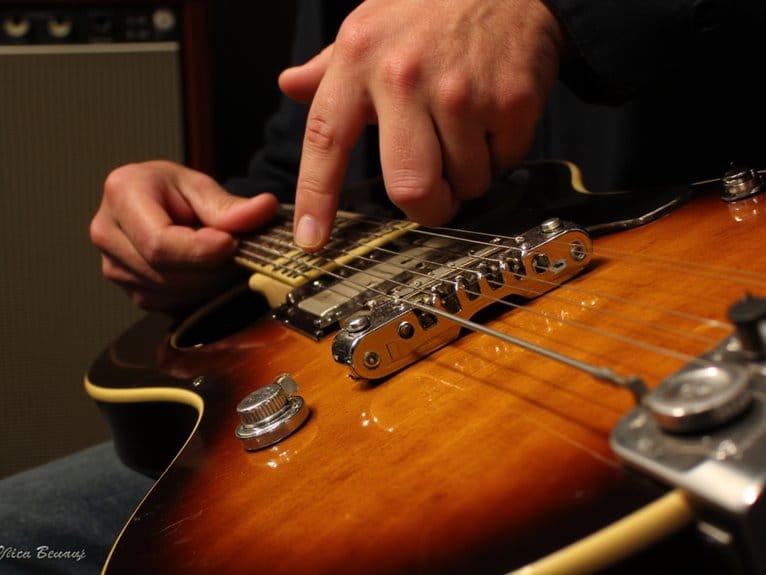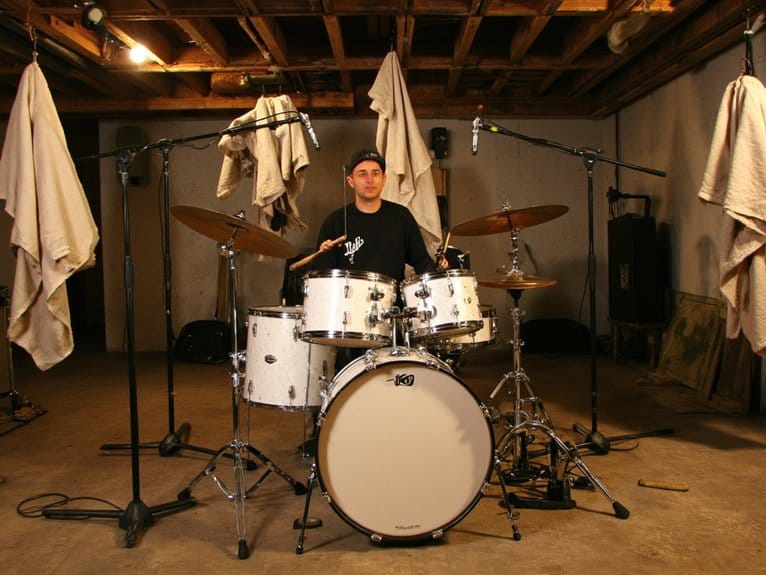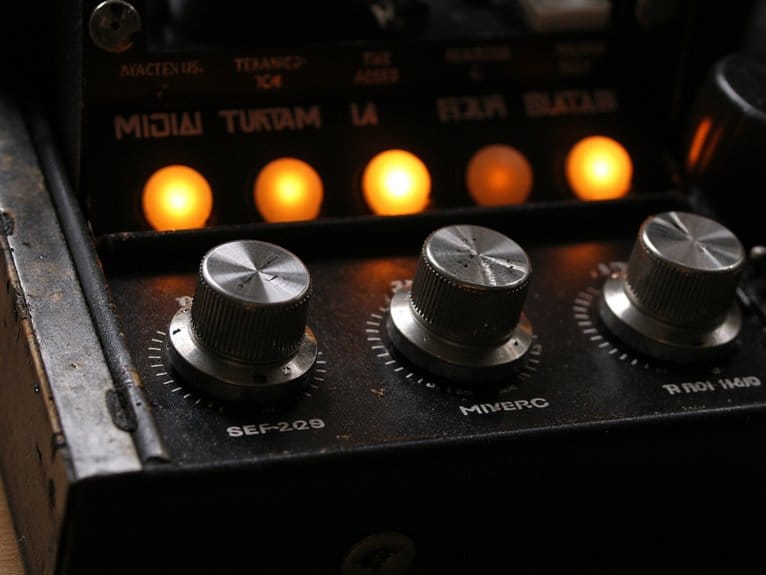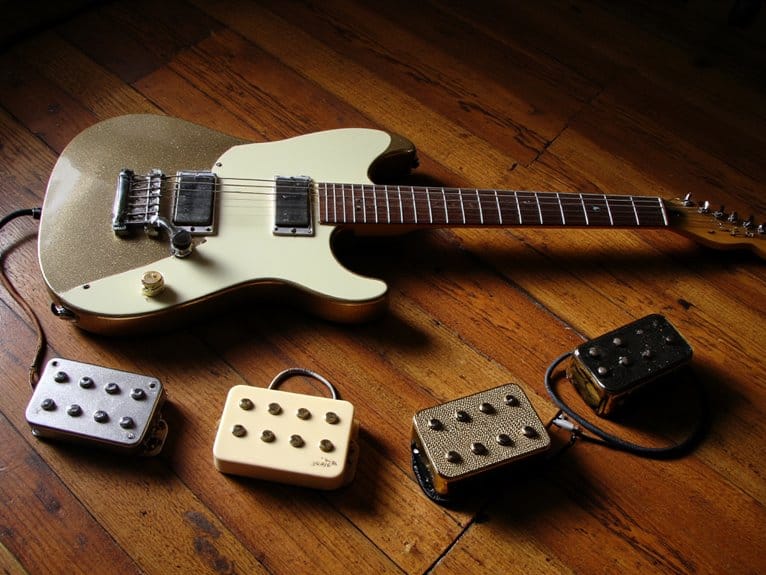Understanding Guitar EQ and Tone Shaping
Understanding guitar EQ starts with managing your frequency spectrum—you’ll want to high-pass filter around 80Hz to eliminate muddy low-end, cut problematic frequencies between 250-500Hz that create boxiness, and enhance presence around 2-5kHz for clarity and articulation. Your midrange frequencies from 200Hz to 2kHz define your guitar’s character, while gentle slope filtering preserves natural warmth without conflicting with other instruments in dense mixes, and mastering these foundational techniques opens advanced tone-shaping possibilities.
We are supported by our audience. When you purchase through links on our site, we may earn an affiliate commission, at no extra cost for you. Learn more.
Notable Insights
- Guitar frequencies span from 82 Hz fundamentals to kilohertz harmonics, requiring balanced EQ across low-end, midrange, and upper frequencies.
- Cut problematic frequencies first: remove muddiness around 250-400 Hz and use high-pass filtering around 80 Hz for clarity.
- Boost midrange presence around 2-5 kHz for articulation and cut through dense mixes without creating harshness.
- Adjust EQ based on guitar’s role: supporting instruments need generous cuts while lead parts require preserved presence zones.
- Genre determines EQ approach: clean tones need warmth and sparkle, rock emphasizes midrange, country favors scooped mids.
Guitar Frequency Spectrum Fundamentals
When I first started diving deep into guitar tone shaping, I quickly realized that understanding the instrument’s frequency spectrum isn’t just technical knowledge—it’s the foundation that separates amateur tweaking from professional sound crafting.
Your guitar’s fundamental range spans from 82 Hz on the low E string to nearly 400 Hz on the high E, though harmonic resonance extends well into several kilohertz territory.
Guitar fundamentals span 82-400 Hz, but harmonic resonance reaches into the kilohertz range where true tonal magic happens.
Effective frequency analysis reveals that guitar tuning creates distinct tonal zones: low frequencies provide body, midrange shapes character, and upper harmonics deliver brightness. Modern extended-range instruments like 7-string guitars add even deeper low-end response with the additional B1 string at 62 Hz.
Understanding this spectral balance transforms your tone perception, enabling precise guitar dynamics control. This knowledge of frequency ranges is crucial for effective EQing, balancing science and artistic expression in sound production.
Through careful sound layering and strategic tonal enhancement, you’ll craft professional-quality tones that sit perfectly in any mix. When recording these carefully crafted tones, 48 kHz sample rates effectively balance audio quality with optimal system performance. Quality audio interfaces can capture these subtle frequency nuances with high-resolution recording capabilities, ensuring your carefully shaped guitar tones translate accurately from your amplifier to your digital audio workstation. Professional condenser microphones with extended frequency response can accurately capture the full harmonic spectrum of your guitar recordings.
Low-End Management and High-Pass Filtering
Three fundamental principles govern effective low-end management in guitar production, and I’ve learned that mastering high-pass filtering represents the cornerstone technique that separates muddy, amateur mixes from professional-sounding tracks.
Your low end adjustment strategy should target frequencies below 20-50 Hz that consume headroom without adding musical value, while filter settings around 50 Hz on guitars maintain clarity without conflicting with kick drum fundamentals.
When implementing high-pass filtering effectively, consider these essential approaches:
- Apply contextual filtering – Listen within the full mix context rather than solo mode to maintain proper balance
- Use gentle slopes – Avoid excessively steep filtering that removes warmth and body from your guitar tone
- Target frequency ranges – Focus cuts around 300 Hz to reduce muddiness while preserving the instrument’s natural character
Understanding frequency responses becomes crucial when selecting the right microphones for capturing guitar tones, as dynamic and condenser microphones each specialize in different frequency ranges.
Professional microphones typically feature 20Hz-20KHz response ranges that capture the full spectrum of guitar harmonics and overtones across the audible frequency range.
The key to achieving professional-sounding guitar tracks lies in understanding how tailored strategies must be developed uniquely for each song’s requirements and tonal goals. Modern audio interfaces provide zero-latency monitoring capabilities that allow guitarists to hear their processed tone in real-time during recording sessions.
Midrange Character and Presence Control
The midrange frequencies from 300 Hz to 5 kHz form the heart of your guitar’s character, containing the fundamental frequencies that determine whether your instrument sounds full-bodied or thin, present or buried in the mix.
Understanding how presence band control operates around 3-5 kHz becomes essential for cutting through dense arrangements, while the lower mids around 400-500 Hz contribute warmth and body that can quickly turn muddy if you’re not careful with your EQ choices.
I’ve found that mastering these character shaping techniques, particularly knowing when to cut rather than boost specific midrange frequencies, makes the difference between guitars that fight for sonic space and those that sit perfectly in any musical context. True bypass circuitry in dedicated EQ pedals ensures that when the EQ is disengaged, your original midrange character remains completely untouched and uncolored. Modern multi-effects pedals often include sophisticated EQ modules alongside amp modeling and cabinet simulations, allowing you to shape these critical midrange frequencies directly within your signal chain.
While EQ shapes your fundamental tone character, compression pedals work alongside these frequency adjustments to enhance sustain and definition by smoothing dynamics and ensuring clarity throughout your performance.
Midrange Frequency Fundamentals
Guitar’s midrange frequencies, spanning roughly 200 Hz to 2 kHz, form the backbone of your instrument’s character and determine whether your sound cuts through a mix or gets buried beneath layers of competing instruments.
This vital frequency range houses your guitar’s fundamental notes and essential harmonics, making midrange balancing absolutely essential for achieving professional tonal clarity.
Understanding this spectrum requires recognizing three distinct zones:
- Low-mids (200-500 Hz) – Controls warmth and body, but excess creates muddiness
- High-mids (500 Hz-2 kHz) – Enhances articulation and attack without harshness
- Fundamental-harmonic balance – Maintains natural tone reproduction and instrument recognition
Your ear’s sensitivity to midrange frequencies means even subtle adjustments become immediately noticeable, affecting everything from perceived fullness to your guitar’s ability to compete with vocals and other instruments in complex arrangements.
The midrange response also varies significantly based on your instrument choice, as guitars with poplar bodies tend to offer more balanced, neutral tones in these crucial frequencies compared to other wood types. Bass players working in the same frequency range can achieve complementary warm tones using instruments with basswood bodies paired with maple necks.
Many guitarists achieve their signature rock tones by pairing effective midrange EQ with high-output pickups that naturally emphasize these crucial frequencies for enhanced presence and cut.
Presence Band Control
While traditional EQ controls operate within the preamp section of your amplifier, the presence control takes a fundamentally different approach by working primarily in the power amp stage. It doesn’t actually boost frequencies but instead reduces the natural high-frequency roll-off that occurs in tube circuits.
This unique positioning gives you control over your amp’s “air” and brightness without interfering with your bass, mid, or treble settings, making it a crucial tool for tonal precision.
Understanding presence control mechanics helps you dial in that elusive quality that makes notes cut through dense mixes. You’re basically adjusting how much high-frequency content survives the power amp’s natural filtering, which explains why presence adds clarity and definition without drastically altering your amp’s fundamental character or warmth. Just as proper weight distribution is essential for comfort during extended playing sessions, presence control helps distribute your guitar’s frequency content effectively across the mix. Like making micro-tuning adjustments on drums for performance precision, fine-tuning your presence control allows for subtle but crucial tonal refinements that enhance your overall sound quality.
For consistent results when recording, pairing your amplifier with a quality audio interface ensures your carefully sculpted presence settings translate accurately through high-performance converters and preamps.
Character Shaping Techniques
Mastering midrange character represents perhaps the most critical skill in guitar tone shaping, since this frequency band between 200 Hz and 2 kHz fundamentally defines your instrument’s voice and determines whether you’ll cut through a mix or disappear into sonic obscurity.
My approach to midrange enhancement techniques starts with understanding how different frequency zones affect your overall sound.
Here’s my three-step process for effective tonal depth adjustments:
- Cut problem frequencies first – Remove muddiness around 200-400 Hz before boosting
- Enhance attack clarity – Emphasize 800 Hz to 2 kHz for better articulation
- Shape genre-appropriate warmth – Boost 300-500 Hz for body without boom
I’ve learned that starting with neutral EQ settings, then gradually cutting problematic frequencies rather than boosting others, provides cleaner results and maintains your guitar’s natural character. Just as drummers must balance portability with durability when selecting equipment for frequent gigging, guitarists need to consider how their tone shaping decisions will translate across different venues and performance contexts. Many modern combo amps feature multiple channels that allow you to switch between different EQ settings instantly, making it easier to compare your tonal adjustments in real-time. Similarly, when working with dynamic microphones that have naturally low output levels, you’ll need audio interfaces with sufficient preamp gain capabilities to capture the full warmth and character of your guitar’s tone without introducing noise.
High-Frequency Clarity and Articulation
The quest for crystal-clear guitar articulation lives in the delicate balance between presence and harshness, where frequencies between 2.5 kHz and 8 kHz hold the key to making every note cut through your mix with surgical precision.
Your tuning techniques must incorporate strategic frequency layering, targeting the sweet spot around 5 kHz for enhanced sparkle without fatigue-inducing harshness. I’ve found that tone adjustments above 8 kHz contribute atmospheric shine but require careful filtering to prevent unnecessary noise from clouding your sonic texture.
Surgical EQ cuts between 250-500 Hz eliminate boxiness, allowing high-frequency clarity to emerge naturally, while modest 2 kHz boosts breathe life into bland tones. Many overdrive distortion pedals feature dedicated tone controls that allow precise adjustment of these critical frequency ranges, enabling guitarists to shape their high-end response without relying solely on amplifier settings. Multi-effect processors often provide extensive tone-shaping options across multiple frequency bands, offering versatile control over your guitar’s frequency response for different musical genres.
Genre-Specific EQ Approaches
How often have you found yourself chasing that perfect guitar tone, only to realize that what sounds incredible for jazz falls completely flat in a metal context?
Genre comparisons reveal dramatic tonal variations that demand specific EQ approaches, and I’ve learned these differences the hard way through countless studio sessions.
Each genre demands its own sonic fingerprint—what crushes in one style often crumbles in another, requiring complete EQ rethinking.
Understanding these genre-specific requirements helps you dial in appropriate settings faster:
- Clean tones benefit from gentle 80Hz warmth boosts and subtle 6kHz sparkle for articulation.
- Rock styles emphasize aggressive midrange presence around 3kHz with strategic mud-cutting at 400Hz.
- Country approaches scoop mids while boosting treble for characteristic twang and brightness.
Each genre’s sonic DNA requires different frequency emphasis, making your EQ choices critical for achieving authentic, professional results that cut through the mix appropriately.
Mix Context and Frequency Masking
When you’re shaping your guitar’s EQ, you can’t simply focus on making it sound great in isolation, because what works during solo practice often creates frequency conflicts when other instruments enter the mix.
I’ve learned that guitars typically compete with vocals in the critical 1-5kHz midrange territory, while rhythm guitars can easily clash with bass instruments in the lower frequencies, creating that muddy sound we all want to avoid.
Your EQ decisions must account for these potential masking issues from the start, which means you’ll need to make contextual adjustments that carve out distinct frequency spaces for each element in your arrangement.
Frequency Conflict Resolution
Although frequency conflicts might sound like a technical nightmare reserved for mixing engineers, I’ve found that understanding how different instruments compete for the same sonic space is essential for any guitarist who wants their playing to cut through a mix effectively.
Frequency masking occurs when your guitar’s fundamental frequencies overlap with vocals, bass, or drums, creating psychoacoustic effects that muddy your carefully crafted tone.
Here’s my approach to resolving these conflicts:
- Use subtractive EQ techniques to carve out specific frequency ranges rather than boosting competing areas.
- Apply dynamic compression with sidechain triggering to duck your guitar when vocals or lead instruments need prominence.
- Implement stereo imaging and spectral analysis to identify problematic overlap zones before they compromise your mix.
Instrument prioritization determines which elements deserve frequency real estate, ensuring your guitar serves the song’s arrangement goals.
EQ Adjustments in Context
Since every guitar tone I’ve crafted in isolation has sounded drastically different once placed within a full mix, I’ve learned that context-sensitive EQ adjustments represent the difference between professional-sounding recordings and amateur hour.
Your guitar’s role determines your EQ prioritization strategies—rhythm guitars typically require aggressive subtractive EQ techniques around 2-3 kHz to clear space for vocals, while lead guitars demand careful frequency carving techniques that preserve their cutting power.
I’ve found dynamic EQ applications particularly useful when guitars occasionally clash with other midrange instruments, allowing natural tone during non-competing passages.
Instrument role considerations drive every decision: if you’re supporting the mix, cut frequencies generously; if you’re leading, preserve your presence zones while still contributing to overall mix clarity optimization through strategic frequency management.
Essential EQ Tools and Techniques
Mastering your guitar’s tone starts with understanding the fundamental EQ tools at your disposal, and I’ve found that knowing which tool to reach for can make the difference between a muddy mess and a crystal-clear sound that cuts through any mix.
Parametric EQs offer surgical precision for targeting specific frequency ranges, while shelf EQs handle broad tonal adjustments across highs and lows with remarkable efficiency.
Graphic EQs provide intuitive slider-based control that’s perfect for quick tone sculpting.
Here’s my go-to frequency targeting approach:
- Cut 250-500 Hz to eliminate muddiness in distorted tones
- Boost 2-5 kHz to enhance presence and articulation
- High-pass around 80-100 Hz to clean up unnecessary low-end rumble
These tools become extensions of your creative process once you understand their strengths.
Frequently Asked Questions
Should I EQ My Guitar Differently When Recording Versus Live Performance?
You should absolutely EQ differently for each situation. Recording environment demands subtle cuts for mix integration, while live acoustics require stronger boosts and cuts to cut through band sound and venue reverb.
How Do Different Guitar Pickup Types Affect My EQ Decisions?
Your pickup choice drastically changes EQ needs. Humbucker characteristics include warmer tone with high-frequency rolloff, letting you boost treble aggressively. Single coil response offers brighter sound requiring careful high-end taming to avoid harshness.
What EQ Adjustments Work Best for Acoustic Guitars in a Mix?
You’ll need to contemplate frequency ranges based on your acoustic’s tone woods. Cut around 250-300Hz for muddiness, boost 1-3.5kHz for definition, and enhance 3.5-7kHz for string clarity and presence.
How Can I Use EQ to Fix Guitar Feedback Issues?
You can achieve feedback suppression by sweeping your EQ to identify problematic frequencies, then notching them out with narrow cuts. This maintains tone enhancement while eliminating feedback loops without compromising your overall sound quality.
Should I Apply EQ Before or After Guitar Effects Pedals?
You’ll want EQ placement based on your goals in the effect chain. Place EQ before overdrive pedals to shape your guitar’s raw tone and distortion character. Use pedal order with EQ after effects for final tone polishing.
On a final note
You’ve now got the fundamental knowledge to shape your guitar’s sonic character with confidence, though I’ll admit mastering EQ takes years of practice and plenty of mistakes. Start with subtle adjustments around 80Hz for tightness, 400-800Hz for warmth, and 2-5kHz for presence, then trust your ears over any preset. Remember, context matters more than isolation—what sounds perfect solo might disappear in a full mix.







